|
|
|
Sort Order |
|
|
|
Items / Page
|
|
|
|
|
|
|
| Srl | Item |
| 1 |
ID:
085359
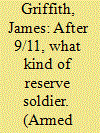

|
|
|
|
|
| Publication |
2009.
|
| Summary/Abstract |
Two concepts, Moskos's institutional-occupational orientations and Meyer and Allen's organizational commitment, were used to develop several hypotheses concerning relationships of soldiers' stated reasons for joining and staying in reserve military service to their stated career intentions and to perceived unit readiness. Survey data were obtained from first-term, junior-ranking enlisted Army National Guard soldiers nationwide at three time periods. Time periods corresponded to different phases of the Iraq conflict- before, during, and after the initial invasion. The number of soldiers at each time period equaled about 7,000 to 8,500. Results suggest material incentives may increase recruitment and retention, yet at the same time, such incentives may not enhance readiness. Rather, incentives fostering normative and affective commitments, such as joining and staying for camaraderie and service to country, were related both to self-reported career intentions and perceived unit readiness.
|
|
|
|
|
|
|
|
|
|
|
|
|
|
|
|
| 2 |
ID:
091691
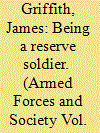

|
|
|
| 3 |
ID:
189932
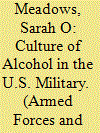

|
|
|
|
|
| Summary/Abstract |
Excessive alcohol use, especially binge and heavy drinking, represents a serious threat to force readiness across the Department of Defense. Though these behaviors are a matter of individual service member choice, they are influenced by perceptions of the culture of alcohol use in the military. This paper uses data from the 2018 Health Related Behaviors Survey of Active Duty service members to explore associations between perceived alcohol culture and excessive alcohol use, any serious drinking consequences, risky driving behaviors, productivity loss due to drinking, absenteeism, and presenteeism. Results from multivariate logistic regression reveal a strong, positive correlation between positive perceptions of drinking culture in the military and all outcomes. Targeting perceptions of the drinking culture is one way the military can reduce excessive and unhealthy use of alcohol and negative sequelae.
|
|
|
|
|
|
|
|
|
|
|
|
|
|
|
|
| 4 |
ID:
073813


|
|
|
| 5 |
ID:
161523
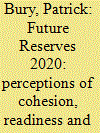

|
|
|
|
|
| Summary/Abstract |
The British Army Reserve, and in particular its logistics component, is currently undergoing profound organisational transformation as part of the Future Reserves 2020 (FR20) program. Yet, to date there has been no sustained quantitative analysis of perceptions of cohesion, readiness and morale in the Army Reserve. Moreover, there has been little quantitative examination of FR20’s impact to date. This paper addresses these gaps in the literature by undertaking an examination of the above variables using survey data from a representative sample of AR logistics soldiers collected longitudinally. It finds that cohesion is highly important in explaining variance in perceptions of readiness and morale, and that perceptions of cohesion, readiness and morale are relatively high in the force. Nevertheless, the data indicates that FR20 has failed to increase these significantly over time. Similarly, it finds that confidence in FR20 delivering increased military capability is also declining. These findings are important for understanding FR20’s impact to date and future trajectory.
|
| Contents |
The British Army Reserve, and in particular its logistics component, is currently undergoing profound organisational transformation as part of the Future Reserves 2020 (FR20) program. Yet, to date there has been no sustained quantitative analysis of perceptions of cohesion, readiness and morale in the Army Reserve. Moreover, there has been little quantitative examination of FR20’s impact to date. This paper addresses these gaps in the literature by undertaking an examination of the above variables using survey data from a representative sample of AR logistics soldiers collected longitudinally. It finds that cohesion is highly important in explaining variance in perceptions of readiness and morale, and that perceptions of cohesion, readiness and morale are relatively high in the force. Nevertheless, the data indicates that FR20 has failed to increase these significantly over time. Similarly, it finds that confidence in FR20 delivering increased military capability is also declining. These findings are important for understanding FR20’s impact to date and future trajectory.
|
|
|
|
|
|
|
|
|
|
|
|
|
|
|
|
| 6 |
ID:
081059
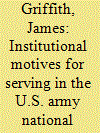

|
|
|
|
|
| Publication |
2008.
|
| Summary/Abstract |
The present study extended recent investigations of the motivations of American youth and active-duty soldiers to serve in the military. Unlike previous studies, this study employed a sample of reservists and examined their reasons for joining. Consistent with recent studies, institutionally-motivated soldiers were more likely to plan to remain in military service, would report for duty so they did not let their buddies and family down, and believed in the mission and service to the country. In contrast, materially-motivated soldiers were less likely to remain in reserve military service if deployed overseas, more likely to report for duty to meet contractual obligations and to avoid disciplinary actions, but less likely to report to serve the country. These factors have implications for the level of commitment and combat readiness of soldiers, in particular Army reservists, who are increasingly relied on for national defense strategy.
|
|
|
|
|
|
|
|
|
|
|
|
|
|
|
|
| 7 |
ID:
130754
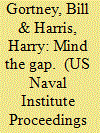

|
|
|
|
|
| Publication |
2014.
|
| Summary/Abstract |
The Readiness Kill Chain helps the Navy bridge Fleet challenges and ensure its forward-deployed forces are mission ready.
Our job as fleet commanders is to provide the United States with ready, forward-deployed naval forces. This takes concerted teamwork and many distinct partners working together toward a common goal. However, the organizations and rules responsible for developing readiness for deployable units have grown over time. The Navy originally built these entities to guide specific parts of the process but did not necessarily integrate them into the readiness production system as a whole.
|
|
|
|
|
|
|
|
|
|
|
|
|
|
|
|
| 8 |
ID:
129049
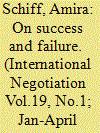

|
|
|
|
|
| Publication |
2014.
|
| Summary/Abstract |
This study presents a comparative analysis of two case studies in which attempts were made to resolve intractable ethno-national conflicts: the peace process undertaken in Aceh between the Government of Indonesia and the Free Aceh Movement, which led to the signing of the Helsinki Memorandum of Understanding (mou) ending the conflict in Aceh; and the process conducted in the Sri Lanka conflict from 2001 through 2004 between the Government of Sri Lanka and the Tamil Tigers, which failed to yield an agreement. The two peace processes will be examined using readiness theory, which focuses on the factors influencing the decision to enter into negotiations. This article also attempts to extend the hypotheses of readiness theory to explore the process of concession-making during the negotiations that took place in the two case studies. The findings indicate that the theory does contribute to understanding the dynamics of the pre-negotiation in both case studies and that applying its hypotheses may contribute to the understanding of the dynamics of the process of reaching an agreement in the Aceh process and of the factors leading to the failure of the negotiations in the Sri Lanka conflict. The analysis also gives rise to some questions that challenge readiness theory and its hypotheses - empirically and methodologically.
|
|
|
|
|
|
|
|
|
|
|
|
|
|
|
|
| 9 |
ID:
165682
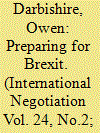

|
|
|
|
|
| Summary/Abstract |
The UK ‘Brexit referendum’ set in motion a unique and highly complex set of negotiations to withdraw from a fundamentally embedded economic and political union. The final referendum was preceded by a nine-month pre-negotiation phase; this article examines the dynamics of that stage. The context of a unilaterally initiated negotiation, together with the economic and political costs associated with it, distinguish it from the existing literature. Three analytical approaches are combined and built upon in this article: the tasks of the pre-negotiation phase, the readiness of the temporal moment, and the demands of multi-level, multi-party negotiations. The concept of psychological readiness has broad theoretical import, though explicit recognition is given that negotiators are not unitary decision makers and that the incorporation of a political analysis is required. The combination of these frameworks provides insight into the dynamics of this phase and the difficulties experienced by both the UK and EU27.
|
|
|
|
|
|
|
|
|
|
|
|
|
|
|
|
| 10 |
ID:
178452
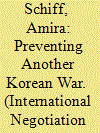

|
|
|
|
|
| Summary/Abstract |
This study explores the relevance of readiness theory’s analytical framework in illuminating the fundamentals that contribute to the de-escalation process in international crises. By applying this analytical framework to the U.S.-North Korea crisis management episode of 2017–2018, this study elucidates the interplay of elements that led to the winding down of the intense crisis and to the parties’ agreement to formally embark on negotiations at the end of the Singapore Summit in June 2018. The study shows how the multiple variables underlying the movements in conflict transformation, as outlined by readiness theory, can help to explain the effect of bilateral strategies applied by the U.S. and North Korea and the role of third-party involvement by South Korea and China in managing the crisis.
|
|
|
|
|
|
|
|
|
|
|
|
|
|
|
|
| 11 |
ID:
184988
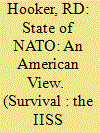

|
|
|
|
|
| Summary/Abstract |
For 70 years, the North Atlantic Treaty Organization has been the backbone of American and European security and a major force for global stability. The unifying threat is now Russia, a quasi-imperial power whose leader, President Vladimir Putin, is intent on reasserting the country’s control over its ‘near abroad’ and re-establishing its status as a great power. Russia’s aggression in Ukraine has produced cohesive Western and in particular NATO resistance, while its military performance there has been stunningly poor. After it rebuilds its economy and military, however, more Russian aggression is possible and perhaps likely. Given Russia’s reckless aggression in Ukraine, NATO members’ readiness and implementation, especially in the front-line Baltic states, now merit more robust discussions. NATO must also revise its Strategic Concept to reflect the primacy of the Russian threat. Above all, the Alliance must have the will to compete, and the US must lead and encourage it.
|
|
|
|
|
|
|
|
|
|
|
|
|
|
|
|
| 12 |
ID:
138681
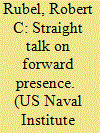

|
|
|
| 13 |
ID:
102492
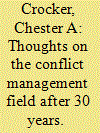

|
|
|
|
|
| Publication |
2011.
|
| Summary/Abstract |
This article surveys the emergence of conflict management from the academic and policy shadows into a far more prominent field of inquiry and practice. As the barriers to entry into third party roles collapsed at the end of the Cold War, the field of conflict management expanded, diversified, and fragmented into a range of practice areas (scholarly, policy-oriented, and operational). Four phases of this evolution are identified. An increasingly crowded field lacks gatekeepers or natural coherence, underscoring the need for leadership and sustained, coordinated efforts. The study of mediation has blossomed around the work of Zartman and others, while the policy community has swung back and forth in its enthusiasm for third party roles in an age where hard power and smart power vie for pride of place. Conflict management responses are increasingly spontaneous, ad hoc and case-specific. Debate is emerging over the pros and cons of engaging with armed non-state actors that are placed on proscribed lists in the struggle against terrorism. Post-conflict challenges continue to pose a severe test to practitioners of peacebuilding.
|
|
|
|
|
|
|
|
|
|
|
|
|
|
|
|
|
|
|
|
|